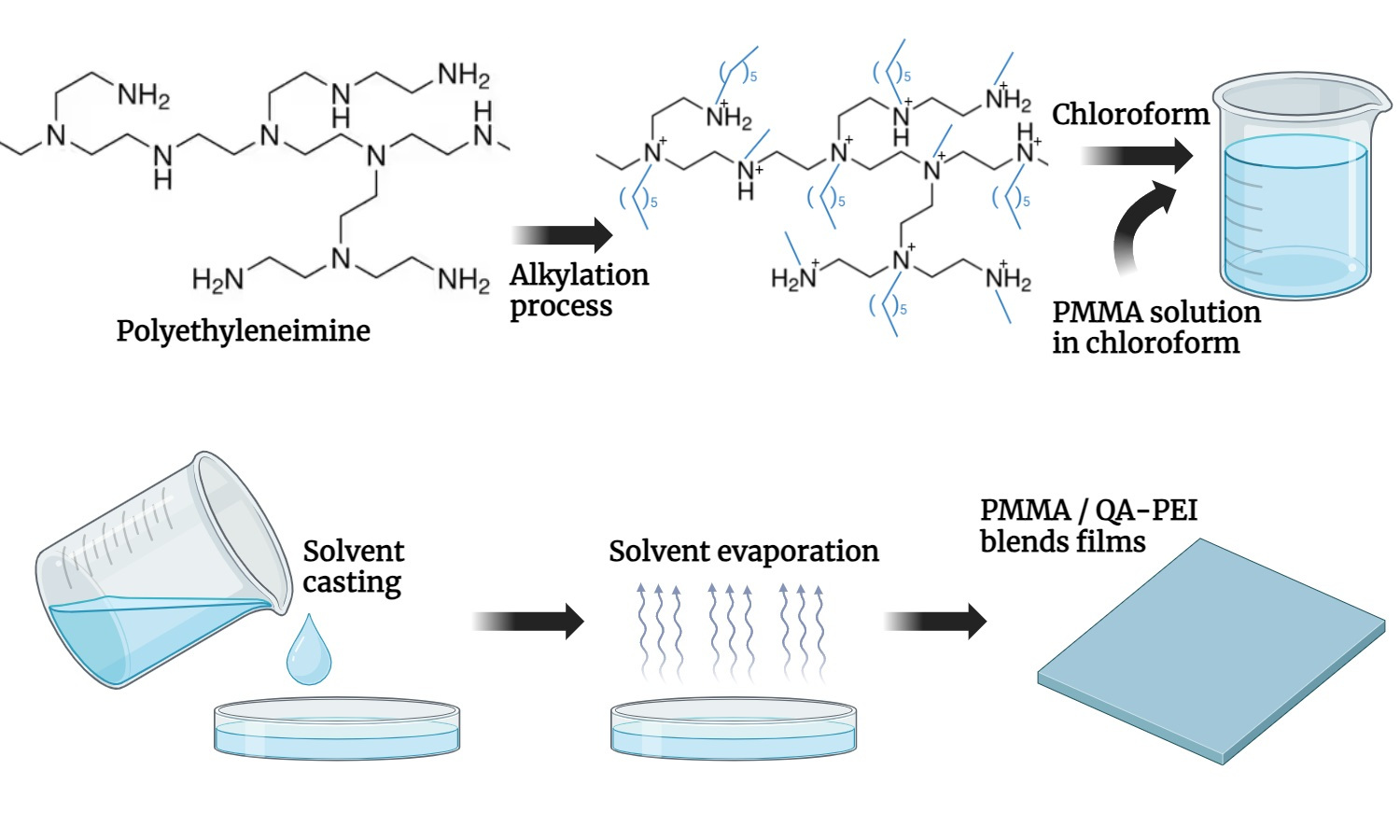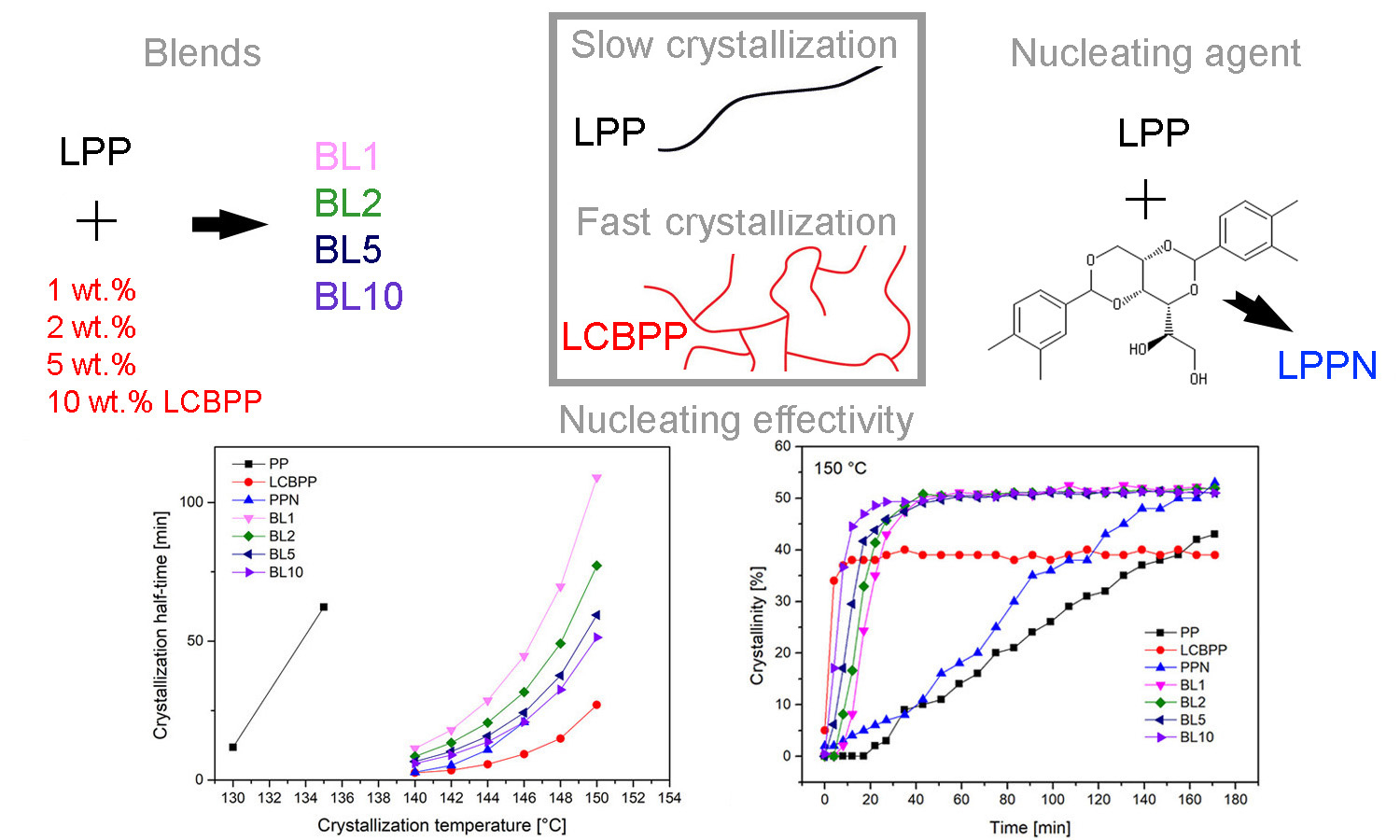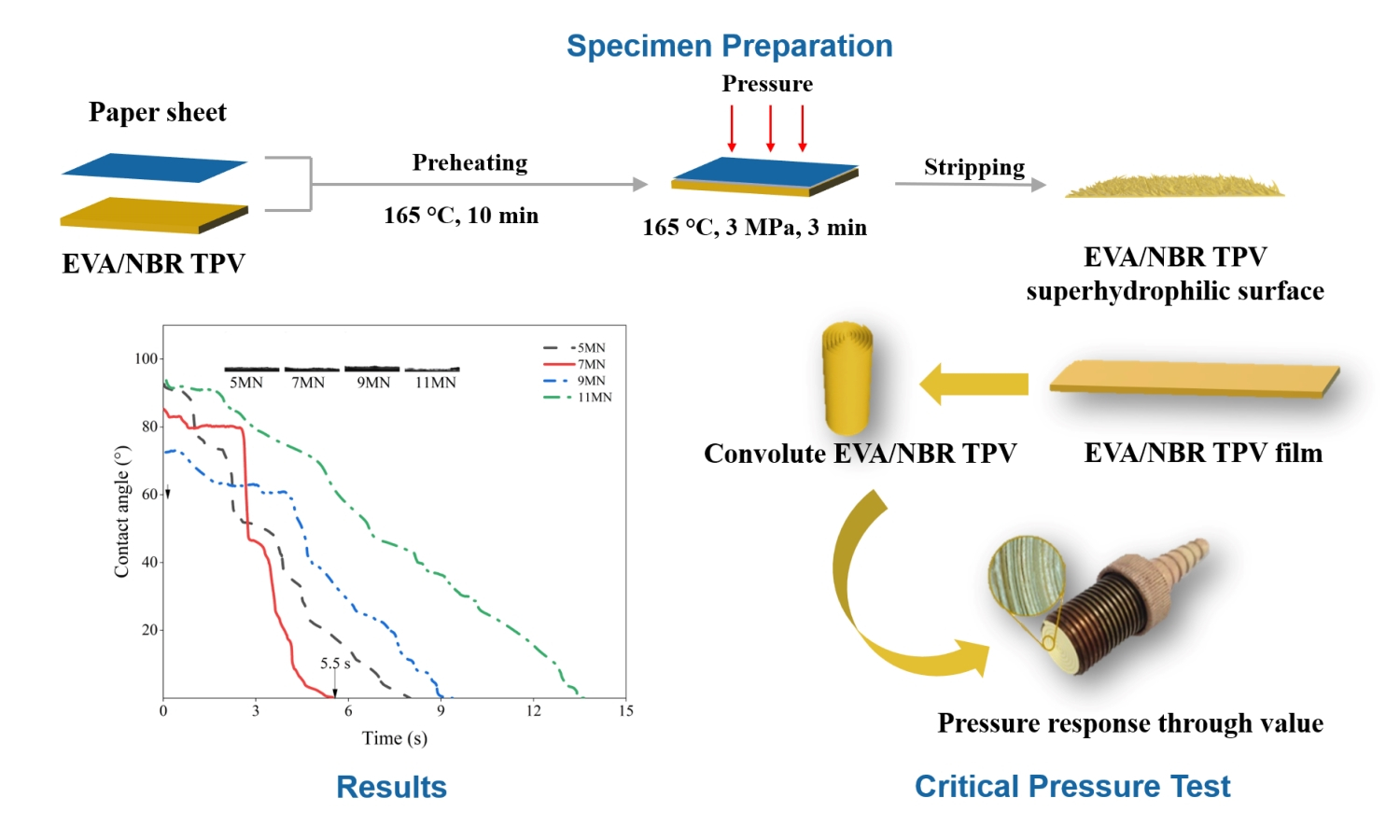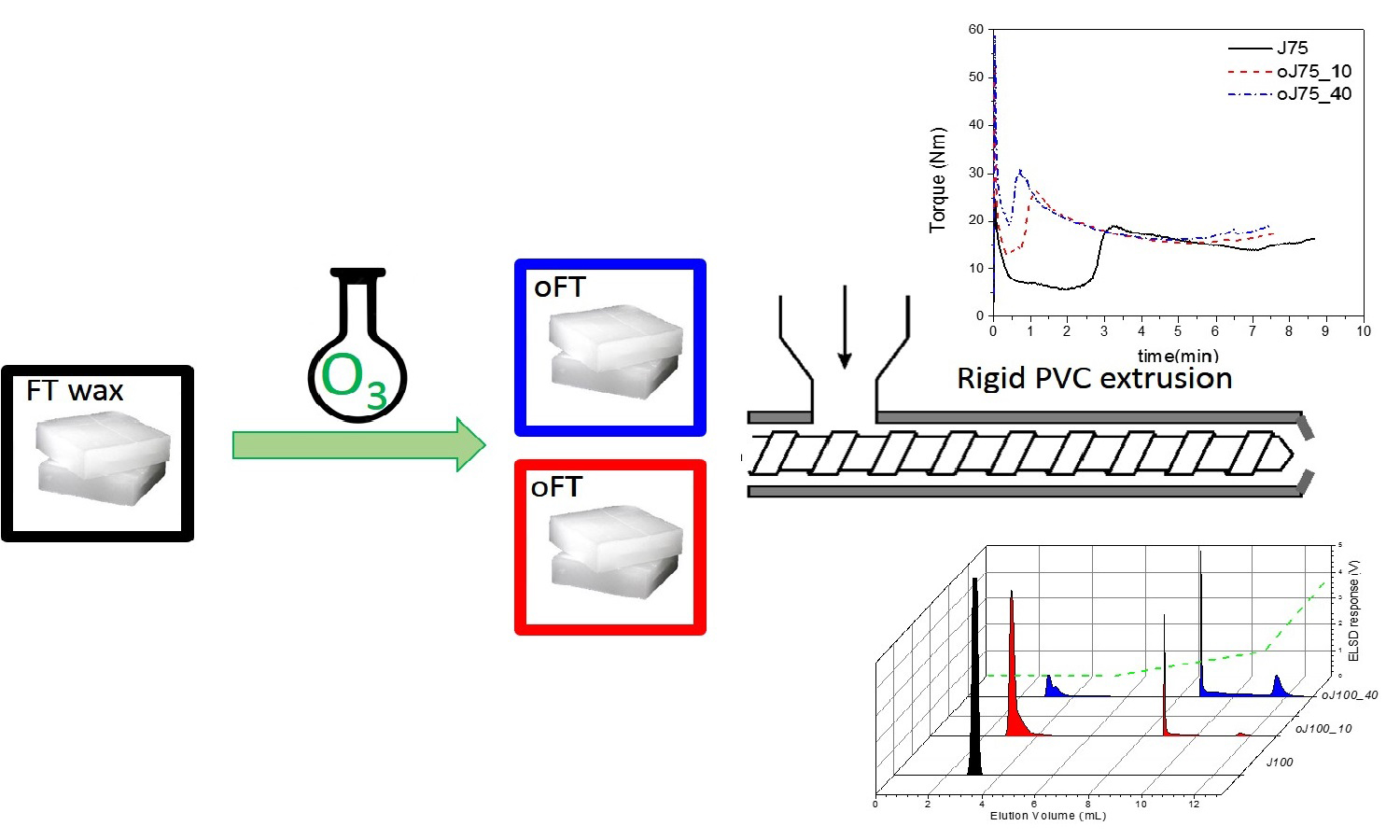Poly(methyl methacrylate) blends with quaternized polyethyleneimine: A study of morphology, optical, thermal and mechanical properties
Rafael Affonso Netto , Guilherme Ribeiro de Carvalho
, Guilherme Ribeiro de Carvalho , Lucas Henrique Staffa
, Lucas Henrique Staffa , Liliane Maria Ferrareso Lona
, Liliane Maria Ferrareso Lona
 , Guilherme Ribeiro de Carvalho
, Guilherme Ribeiro de Carvalho , Lucas Henrique Staffa
, Lucas Henrique Staffa , Liliane Maria Ferrareso Lona
, Liliane Maria Ferrareso Lona
Vol. 19., No.2., Pages 161-175, 2025
DOI: 10.3144/expresspolymlett.2025.12
DOI: 10.3144/expresspolymlett.2025.12
GRAPHICAL ABSTRACT

ABSTRACT
This study aimed first to promote the alkylation of polyethyleneimine (PEI), developing its alkylated (quaternary) form (QA-PEI) by inserting alkyl groups into amine groups. Subsequently, polymer blends with poly(methyl methacrylate) (PMMA) were prepared via solvent casting, and finally, the physicochemical, optical, and mechanical behavior of the resulting PMMA/QA-PEI were assessed. Elemental analyses, Fourier-transform infrared spectroscopy (FT-IR), and hydrogen nuclear magnetic resonance spectroscopy (1H-NMR) confirmed that the PEI alkylation successfully converted the amine groups into quaternary ammonium groups. When added to PMMA, QA-PEI altered its coloration, making it yellow. In addition, higher contents of QA-PEI hindered PMMA transmittance and increased its opacity due to the larger QA-PEI domains. Scanning electron microscopy (SEM) images showed that PMMA and QA-PEI formed a phase-separated system, establishing a droplet-matrix morphology. The thermal and mechanical behavior showed some compatibility between PMMA and QA-PEI as thermal resistance slightly improved and PMMA glass transition temperature (Tg) decreased. The tensile strength was also improved in the PMMA/QA-PEI blends without significant change in strain at break and tensile modulus.
RELATED ARTICLES
Soňa Zenzingerová, Jana Navratilova, Lenka Gajzlerová, Michal Kudláček, David Jaška, Lubomir Benicek, Roman Čermák
Vol. 18., No.9., Pages 921-930, 2024
DOI: 10.3144/expresspolymlett.2024.69
Vol. 18., No.9., Pages 921-930, 2024
DOI: 10.3144/expresspolymlett.2024.69

This study compares the efficiency of commercially available sorbitol-based clarifying agent (NA) and varying amounts of long chain-branched polypropylene (LCBPP) acting as a specific α-nucleating agent for linear polypropylene (PP). The sorbitol-based clarifying agent, 1,3;2,4-bis(3,4-dimethyl benzylidene)sorbitol (Millad 3988), in concentration 0.2 wt%, and LCBPP in the concentration of 1, 2, 5 and 10 wt% were mixed into PP. The comparison of the effect of NA and long branches under isothermal conditions on the crystallization process, crystallinity and polymorphic composition was realized by differential scanning calorimetry and wide-angle X-ray scattering. The addition of long chain-branched polypropylene, even at the lowest concentration, performs better at higher crystallization temperatures and has a superior effect on the crystallization process, crystallization rate and overall crystallization than the addition of NA.
Weiran Zhang, Yuan Gao, Ruotao Feng, Dazhi Zhu, Zhaobo Wang
Vol. 18., No.7., Pages 675-688, 2024
DOI: 10.3144/expresspolymlett.2024.50
Vol. 18., No.7., Pages 675-688, 2024
DOI: 10.3144/expresspolymlett.2024.50

In this research, a straightforward template method was utilized to fabricate a superhydrophilic ethylene-vinyl acetate copolymer (EVA)/nitrile-butadiene rubber (NBR) thermoplastic vulcanizate (TPV) surface where the paper sheet was used as template. Organic modified montmorillonite (OMMT) powder was introduced in order to improve the superhydrophilic response rate of the TPV surface. Investigations were conducted to research the durability and the self-cleaning behavior of the TPV surface, as well as to explore its potential application in the separation of oil-water and oil-oil mixtures. Experimental results demonstrated that the EVA/NBR/OMMT TPV (mass ratio 20/80/7) surface molded with No. 1000 paper sheet exhibited the excellent superhydrophilic property, which could achieve a contact angle of 0.0° within 5.5 s and had a surface energy of 35.6 mN·m–1. The superhydrophilic surface displayed the remarkable durability and the evident self-cleaning behavior; moreover, it could exhibit the significant difference in the critical pressure data for various liquids, suggesting the promising application in the field of oil-water and oil-oil separation.
Johannes Lodewiekus Barnard, Divann Dale Robertson, Albert Johannes van Reenen
Vol. 18., No.2., Pages 118-132, 2024
DOI: 10.3144/expresspolymlett.2024.10
Vol. 18., No.2., Pages 118-132, 2024
DOI: 10.3144/expresspolymlett.2024.10

A set of linear Fischer-Tropsch (FT) waxes were oxidized to various degrees by utilizing an ozonolysis method. These waxes were comprehensively characterized in terms of their chemical composition, thermal behaviour, molecular weight distributions, and overall polarity using various analytical techniques, including Fourier transform infrared spectroscopy (FTIR), nuclear magnetic resonance spectroscopy (NMR), differential scanning calorimetry (DSC), high temperature size exclusion chromatography (HT-SEC) along with normal and reverse-phase high temperature solvent gradient interaction chromatography (HT-SGIC). Application-based studies were performed by evaluating the behaviour of these waxes in unplasticized polyvinyl chloride (uPVC) formulations. Analyses included hot melt mixing, single screw extrusion, scanning electron microscopy coupled with energy dispersive X-ray spectroscopy (SEM-EDS), and torque rheometry. Through a combination of these techniques, the lubrication mechanism of these waxes could be explained by the Rabinovitch model. It was found that a combination of molecular size and degree of polarity play a vital role in the migration of the waxes and therefore ultimately impacts the fusion behaviour of the overall polyvinyl chloride (PVC) formulation. Results indicate that fusion times can greatly be altered when using oxidised waxes, and this could be promising for the development of multifunctional lubricant systems.



